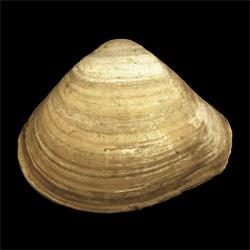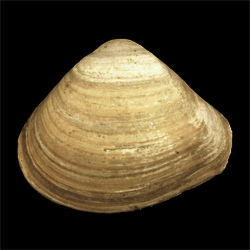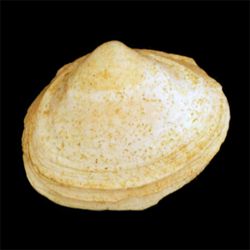
Mactridae

- Phylum: Mollusca
- Class: Bivalvia
- Order: Imparidentia
- Family: Mactridae
Overview
Common name: Surf or trough clams
Key morphological features: The Mactridae range in size up to 225 mm. The shells are equivalve, inflated, and range in outline shape from oval to trigonal or transversely elongated. A narrow gape is usually present at the posterior and sometimes also the anterior, and the posterodorsal area is marked by a high keel or fringe. The shell is composed of aragonite and exterior sculpture is smooth or consists of commarginal ridges occasionally crossed by prominent radial ribs. Valve interiors are non-nacreous and the pallial area has a deep sinus. The interior shell margins are smooth. Species of Mactridae are either isomyarian (with equally-sized adductor muscles) or heteromyarian (with the posterior adductor muscle scar having an oval outline and the anterior adductor muscle scar similar in width, but substantially dorsoventrally elongated). The heterodont hinge has three cardinal teeth and anterior and posterior lateral teeth are present and may be transversely hinged. Source: Mikkelsen, P.M., and Bieler, R. 2008. Seashells of Southern Florida: Bivalves. Princeton, New Jersey: Princeton University Press. 503 pp.
Geological range: Cretaceous to Recent (Mikkelsen & Bieler, 2008).
Geographic distribution: A distributional map for modern Mactridae may be accessed from OBIS. A distributional map for ancient Mactridae may be accessed from the Paleobiology Database.
Diversity: There are 178 recognized living species of Mactridae and 36 genera (WoRMS database, unvetted). The Paleobiology Database recognizes 50 fossil genera and 146 fossil species of Mactridae (unvetted).
Paleoecology: The Mactridae are marine or estuarine filter-feeding bivalves. They live infaunally, buried in shifting sand or sandy mud. Most Mactrids are capable of burrowing rapidly by using their valves to create jets of water in combination with a powerful foot muscle. Mactrids can be found worldwide in relatively shallow waters. Some species have a high salinity tolerance, and can live in areas of entirely fresh water. They may sometimes host symbiotic pea crabs or chemoautotrophic bacteria in the mantle cavity and gills. Source: Mikkelsen and Bieler (2008).
Phylogenetic status: Monophyletic. The molecular phylogenetic analysis by Ni et al. (2012) supports the monophyly of Family Mactridae, with the potentiality for cryptic or sibling species in the Coelomactra antiquata group.

